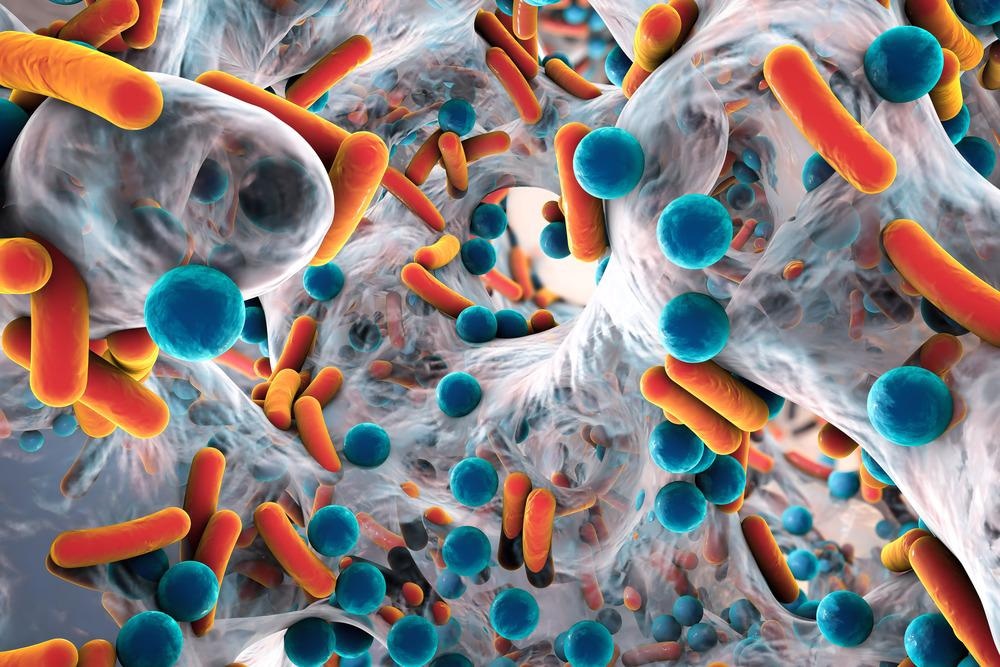Due to their ability to exhibit antibacterial activity without the need for antimicrobial chemicals, nanopillar-textured surfaces have received considerable attention. Despite extensive research on antibacterial nanopillars, their effect on hydrophobicity on bactericidal activity remains unclear.

Study: Surface Wettability Is a Key Feature in the Mechano-Bactericidal Activity of Nanopillars. Image Credit: Kateryna Kon/Shutterstock.com
In an article recently published in the journal ACS Applied Materials and Interfaces, researchers developed silicon (Si) nanopillars of different hydrophobicities from superhydrophilic to superhydrophobic, and investigated their mechano-bactericidal efficacy against Pseudomonas aeruginosa
Mechano-Bactericidal Effect
Continuous and significant efforts were directed to address the problems associated with bacterial contamination on antibacterial surfaces. These surfaces were fabricated conventionally by incorporating antibacterial chemicals or into the material structure. However, due to a significant increase in bacterial resistance against chemicals, there was a shift to develop technologies relying on surface topography. To this end, mechano-bactericidal surfaces consisting of nanopillars with a high aspect ratio can deform the bacterial cells that adhere to the surface.
Initially, the mechano-bactericidal effect was hypothesized to be induced by adhesion forces between nanopillars and bacteria. Later, other mechanisms were also proposed that rely on stored mechanical energy, motility, and reactive oxygen species (ROS) in nanopillars. Previous studies demonstrated the vital role of external forces on nanopillar-based mechano-bactericide.
The researchers observed that subjecting Pseudomonas aeruginosa to nanopillars with superhydrophilicity under wet conditions resulted in negligible mechano-bactericidal activity. Furthermore, the bactericidal effect was observed after water evaporation or due to trapped bubbles on nanopillars. On the other hand, the role of surface hydrophobicity remains practically unexplored against mechano-bactericidal activity.
Mechano-Bactericidal Activity of Nanopillars
In the present study, the researchers investigated the influence of surface hydrophobicity on the mechano-bactericidal effect. The hydrophobicity of Si nanopillar substrates was systematically varied as mechano-bactericidal materials, termed as NanoSi.
Conjugating silicon-etched superhydrophilic nanopillars with 1H,1H, 2H, 2H perfluorooctyltrichlorosilane (PFTS) was followed by oxidation for a controlled duration, and resulted in various hydrophobicities. The as-prepared substrates were tested against Pseudomonas aeruginosa, and the results revealed that the substrates exhibited negligible mechano-bactericidal property under fully submerged conditions.
Immediately after water evaporation, only hydrophilic substrates could exhibit antibacterial activity, while the hydrophobic substrates showed intact cell populations. Upon analyzing the impact of capillary forces, the results revealed that capillarity was vital for the mechano-bactericidal effect.
Research Findings
The topography of NanoSi features randomly distributed sharp nanopillars. The as-prepared NanoSi has a static water contact angle of fewer than 6 degrees. After treating the substrate with PFTS, the water contact angle of the substrate increased to 156 degrees. Thus, the low surface energy of PFTS, combined with the nanopillar’s surface-area-amplifying effect, dramatically changed the NanoSi wettability.
The PFTS-coated NanoSi showed high water repellence due to its superhydrophobicity and low sliding angle. Treating the PFTS-coated NanoSi in an ultraviolet (UV)-ozone chamber resulted in a surface with intermediate hydrophobicity that exhibited water contact angles of 48, 90, and 123 degrees. Treating PFTS-coated Si wafer with flat topography in the UV-ozone chamber resulted in surfaces with water contact angles of 90 and 48.
X-ray photoelectron spectroscopy (XPS) analysis revealed that superhydrophilic NanoSi-6 was composed of Si and oxygen (O), and superhydrophobic NanoSi-156 contained a low amount of O and a large amount of fluoride ions anchored to carbon chains that provided an excellent surface bonding for PFTS molecules.
With a decrease in hydrophobicity, the fluoride and carbon concentrations also tend to decrease, while the O concentration increases, suggesting degradation of surface organic molecules. These observations also imply that the surface chemistry constantly changes with hydrophobicity.
Although scanning electron microscope studies explain the link between surface hydrophobicity and consequent bacterial morphological damage, it does not quantitively assess the bactericidal effect. To this end, confocal laser scanning microscopy can analyze the fluorescence signal intensity of green fluorescent protein (GFP)-tagged Pseudomonas aeruginosa.
The results revealed that the damage to the bacterial membrane resulted in GFP leakage and thus significant loss in the fluorescence signal, which is a robust marker to assess the bacterial viability. This technique can overcome issues associated with traditional quantification techniques like colony counting. In evaporation experiments, the bacteria are in a dried state, and the addition of stain solution rehydrates the cell and induces artifacts.
Conclusion
In conclusion, the researchers studied the role of hydrophobicity on nanopillar textured silicon substrate’s antibacterial properties by investigating the mechano-bactericidal activity at different surface hydrophobicities. Regardless of changes in hydrophobicities, no morphological change or reduction in bacterial viability was observed under wet conditions, suggesting the inability of the substrates to provide inherent bactericidal forces.
On the other hand, introducing capillary force on account of water evaporation, morphological damage was consistently observed with hydrophobicity. Surfaces with superhydrophilicity had the highest killing efficiency, while, with increasing hydrophobicity, the substrate bactericidal activity was lost.
Reference
Amin Valiei, Nicholas Lin, Geoffrey McKay, Dao Nguyen, Christopher Moraes, Reghan J. Hill, and Nathalie Tufenkji. (2022) Surface Wettability Is a Key Feature in the Mechano-Bactericidal Activity of Nanopillars. ACS Applied Materials & Interfaces. https://pubs.acs.org/doi/full/10.1021/acsami.2c03258
Disclaimer: The views expressed here are those of the author expressed in their private capacity and do not necessarily represent the views of AZoM.com Limited T/A AZoNetwork the owner and operator of this website. This disclaimer forms part of the Terms and conditions of use of this website.